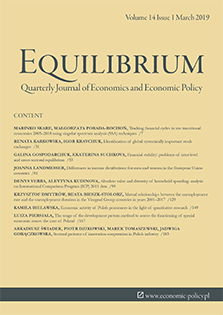Differences in income distributions for men and women in the European Union countries
Differences in income distributions for men and women in the European Union countries
Author(s): Joanna Małgorzata LandmesserSubject(s): Micro-Economics, Labor relations, EU-Approach / EU-Accession / EU-Development
Published by: Instytut Badań Gospodarczych
Keywords: gender pay gap; differences in distributions; decomposition methods;
Summary/Abstract: Research background: Recently there has been an increase in interest in the studies of income inequalities. The findings of numerous empirical studies show that males earn higher wages than females. A variety of techniques of income inequalities decomposition are becoming popular. New procedures go far beyond the Oaxaca-Blinder decomposition. They allow to study differences of income distributions for various groups of people and to decompose them at various quantile points. Purpose of the article: The aim of the paper is to compare personal income distributions in selected countries of the European Union, taking into account gender differences. Methods: First, we examined the income inequalities between men and women in each country using the Oaxaca-Blinder decomposition procedure. The unexplained part of the gender pay gap gave us information about the wage discrimination. Second, we extended the decomposition procedure to different quantile points along the whole income distribution. To describe differences between the incomes of men and women, we constructed the so-called counterfactual distribution, which is a mixture of a conditional distribution of the dependent variable (income) and a distribution of the explanatory variables (individual people’s characteristics). Then, we utilized the residual imputation approach (JMP-approach). Findings & Value added: In the article data from EU-SILC (Statistics on Income and Living Conditions) were used. We found that there exists an important diversity in the size of the gender pay gap across members of the European Union. The results obtained for these countries allowed us to group them into clusters. In general, there are two types of countries in Europe: the countries, where the bulk of the observed income differences cannot be explained by observed characteristics, and the countries, where the explained and the unexplained effects are both positive, with even a bigger explained effect for the lower income ranges.
Journal: Equilibrium. Quarterly Journal of Economics and Economic Policy
- Issue Year: 14/2019
- Issue No: 1
- Page Range: 81-98
- Page Count: 18
- Language: English

